Posted by
Susan Sharma
on
May 19, 2007

|
Chintpurni, Dharamshala, Pragpur, April, 2007
-Partha Praim Pal
It has been long time since we both (Kirti and myself) took a break from Delhi on religious reasons . As some of you are aware we had been blessed by
a daughter some five months back – we undertook a visit to Chintpurni, Chamunda, Kangra Devi and Jwala ji along with Vanya (our daughter).
We reached Chintpurni on 14th evening.
Next morning I woke up very early more due to people’s voice walking in the street – All eager to do a darshan early morning being Basaikhi weekend .Not expecting any bird life
in that cacophony of people ,Radio, Stereo and of course Mandir mike – I moved out of the Dharamshala with heavy feet and heart with my Binoculars hanging on my neck .
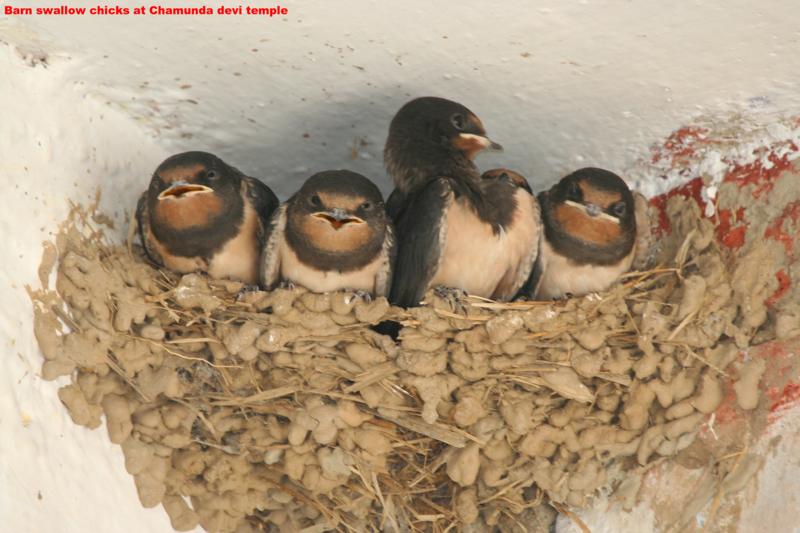
Just 200 mtrs from the Dharamshala, I hit upon a dirt road, which took me to semi jungle kind of a habitat, which lifted my spirit. There was a sudden
expectancy in the air . Nearly 15 pairs of Asian paradise flycatcher with their long white tail fleeting around with few just couple of meters away.
A pair of Blue rock thrush, Flocks of Plum headed Parakeet and Common Rose finches, Ten odd golden orioles and quite a few more species were sighted within span of hour. Only regret being I didn’t listen to Kirti’s advice of carrying the camera for the
walk.

16th afternoon we reached Paragpur our destination for next two days. We stayed in a resort called “Judge’s Court” basically a Pre independence Haveli turned into Welcome heritage resort . As expected luxury at its
best mixed with old royal eloquence. Paradise flycatcher once again was the highlight of the little birding I did around the property, not to miss the Grey Hornbill’s fight for nest with the Rose ringed parakeet who ultimately lost all the three juveniles
to aggressive Hornbill, omnipresent brown headed, Blue throated barbet, tiptoeing Grey wagtail, various warblers, various Myna & starlings,
huge flocks of Common Rose finches etc.
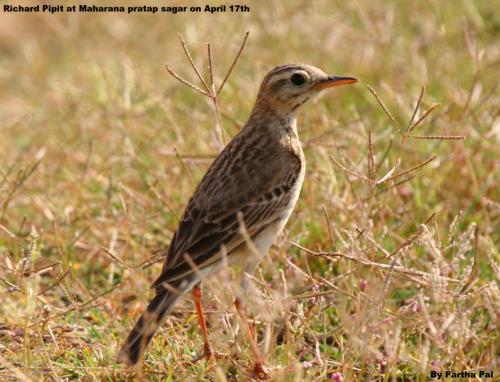
17th was again an out and out
religious day with three of us visiting the balance temples as mentioned above.
Except an odd sighting of Egyptian vulture and Himalayan Griffon at Kangra fort area, no birding.
Down with a severe headache due to excessive heat,
I didn’t have the strength to do any birding that day , though we reached the hotel by 5pm.
18th morning was the D day marked for my morning birding at Maharana Pratap Sagar wetland which is 20 odd kms from the hotel.
Armed with my camera and binoculars ably supported by driver Daler Singh we reached the destination early morning.
Initial scanning of the area was very disappointing though villagers informed us in advance that all migratory ducks have flown back.
I was awe struck by the huge water body.
Initial disappointment gave away to some relief when I saw a Little Ringed plover feeding at the edge of the water.
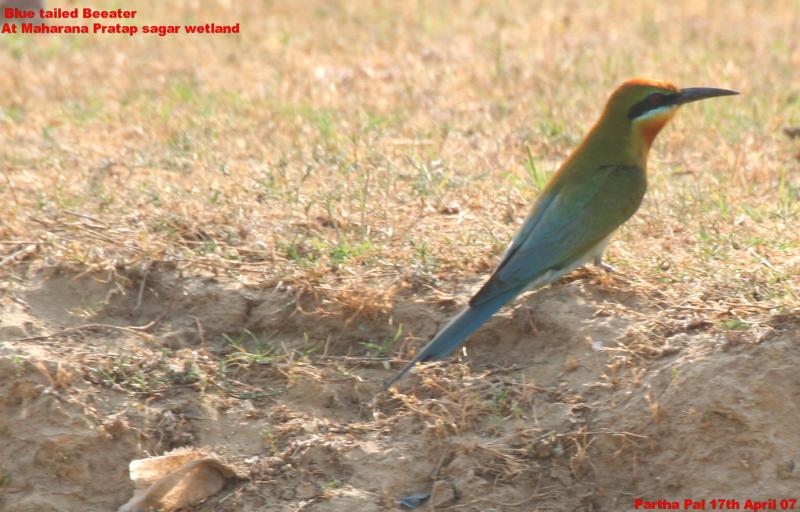
Gradually one after the other species came tumbling out as if they were hidden in some closet – only favouring the brave who can fight the ever rising temperature which was getting unbearable with every minute, though cold
draft from the Sagar did help me to stay there for nearly two hours . Whether it was terns, wagtails, larks, pipits, Blue tailed Beeaters, Bar headed geese,
First winter Palas Gull, Eurasion wigeon, Small pratincole, Lapwings and of course my only two lifer of the trip Richard Pipit and Eurasian Skylark, I enjoyed every bit of the two hour of birding.
I cannot wait to visit the birding paradise again.
(Text and photographs--Partha Pratim Pal )
|
|
|
|
|
Posted by
Susan Sharma
on
May 18, 2007
"Developing world can leapfrog to a new energy future-from no fuel to the most advanced fuel. The biofuel can come from non-edible tree crops-jatropha in India, for example-grown on wasteland, which will also employ people.
This fuel market will demand a different business model. It cannot be conducted on the basis of the so-called free market model, which is based on economies of scale and, therefore, demands consolidation and leads to uncompetitive practices.
In today’s model, a company will grow the crops, extract the oil, transport it first to refineries and then back to consumers.
The new generation biofuel business needs a model of distributed growth in which we have millions of growers and millions of distributors and millions of users. Remember, climate change is not a technological fix but a political challenge. Biofuel
is part of a new future."
-Sunita Narain
Source: http://www.downtoearth.org.in/cover_nl.asp?mode=2
|
Posted by
Susan Sharma
on
May 17, 2007
A regional climate change study is being done on the Godavari (Andhra Pradesh) basin by IIT Delhi and UK based scientists.
The Godavari basin extends over three million sq.km and is nearly 10 % of the total area of India. Because of its size, it provides a diversity of eco systems that will enable scientists to carefully choose sites to study interlinked water dependent eco
systems like forests, wetlands and cropping systems.
Source: Hindustan Times, 23 March , 2007
|
Posted by
Susan Sharma
on
May 17, 2007
Article 48A and Part IV A of the Constitution grant environment supremacy over development. The Constitution, on a sensitive provision in Article 48A states:"The State shall endeavour to protect and improve the environment and to safeguard the forests and
wildlife of the country."
Article 51A (g) creates a fundamental duty in every individual to obey the mandates of environment and ecology.
|
Posted by
Susan Sharma
on
May 16, 2007
Environmental law in India has developed partly in response to demands by environmental groups and partly as a result of international conventions. The laws to protect bio diversity were a direct outcome of the International Convention on Biodiversity.
After the 1992 United Nations Conference on Environment and Development in Rio de Janeiro, a number of laws were changed or new rules drafted to conform to international agreements. Local environment groups played an important role in bringing in the Coastal
Regulation Zone Rules, an outcome of growing awareness of the impact of development along the coasts of marine resources.
Sourece: The Hindu, 23, March, 2007
|
Posted by
Raghavendra Rao
on
May 16, 2007

A Haven for Birds
-RagooRao
The River Kaveri, which takes it’s birth high up in the Western Ghats, flows down Karnataka state feeding the parched lands and turning them into bountiful yielders of precious
food and then meanders through the valleys of Tamil Nadu blessing them with her bountiful precious water for their land, finally merging with the Bay of Bengal.
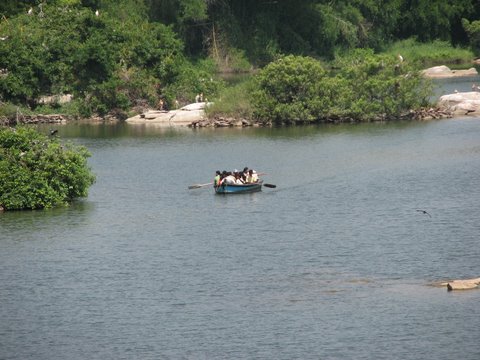
As the river flows through Karnataka over undulating terrain, plenty of small cataracts and some very impressive waterfalls are formed. This river is reverently called the
Life-Line of Karnataka. As the river meanders through the terrain plenty of small islands are formed all the way along it’s course. These islands are a host to plenty of Flora and Fauna all evolving with nature and thriving. One such spot in the river’s course,
close to Mysore-about 12 kilometers, is the Naturally formed group of islands filled with Pandanus plants, Pongamia trees, Mahua trees and a score of other plants playing host to many breeding birds. The banks of the river are filled with Bamboo and other
tall majestic trees. This is The Ranganathittu Bird Sanctuary, where regular nesting birds come to nest and raise their young.
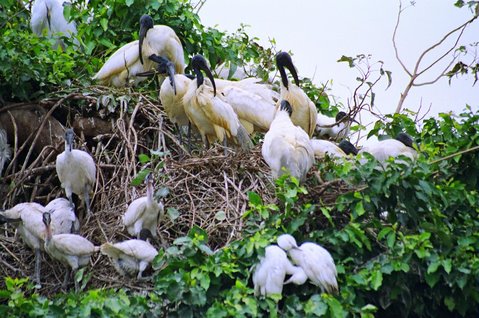
The river being filled with a lot of boulders also plays host to the Marsh Crocodiles and the waters are filled with fish. A pristine home for breeding birds. The
bamboo and other trees also provide a good habitat for most of the birds of Karnataka. The main season for the migratory breeding birds is from Aug to Sept. and
for the other breeding birds it is Dec to March. The islands are a very safe Haven for these nesting birds tucked away inside the deep waters of the river and safe from any land predators. The water being infested with Marsh crocodiles even human interference
and vandalism is kept at bay, thanks to the Marsh crocodiles. In one of the islands even the crocodiles build their nests and breed. One can always find the crocodiles basking on the rocks.
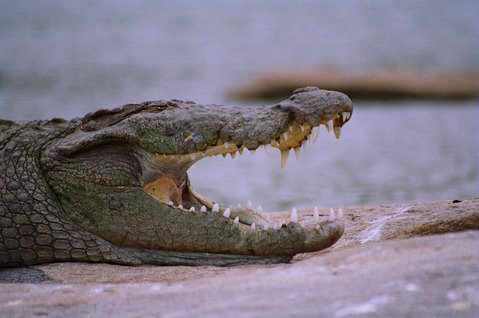
An ideal location for the birds. The river surroundings are all fertile paddy fields, which provide a good source of Crustaceans and other aquatic life as forage for
the parenting birds. The Forest Dept. of Karnataka regulates the visitors to this place and unauthorized entry is prohibited. The serious visitors are taken around these breeding islands by row-boats to have a glimpse of these birds and their young.
Even motor boats are not used to keep noise pollution away.
Visitor facilities are excellent and good view locations are also provided.
There are rest-rooms, a small refreshment canteen a little away from the riverside is also provided. Overnight staying is not possible and also not encouraged by the Forest Dept. In all, Ranganathittu Bird Sanctuary is a Haven for Nature Photographers,
Ornithologists, and a beautiful place to visit.
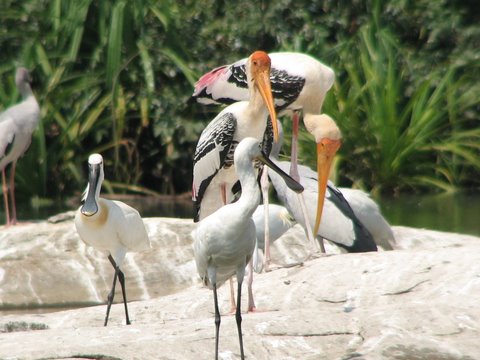
It is really reassuring to see such a Naturally evolved place still maintained in its Pristine condition. Any Nature Lover will enjoy the visit and would always love to
come back often. A List of nesting birds is also displayed with all their details and with appeals to conserve them.
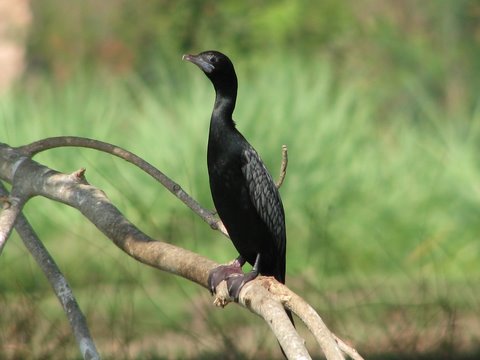
The Regular Birds: Open billed Storks, Painted storks, Spoonbills, White Ibis, Pond Heron, Little Heron, Plumed Heron, Night Heron, Darters, Little Cormorant, River Terns,
Plovers, Red-wattled lapwing, Peacock, Black Ibis, Kingfishers and the River Otters which
are a source of amusement as they dive in and out of sight of the visitors.
(Text and Photographs-RagooRao)
|
Posted by
Susan Sharma
on
May 15, 2007
Wildlife Asia Film Festival took place in March 2007 in Singapore.
"Cherub of the Mist" by Bedi Films (India)won the "Best Asian Film " award. "Village of Dust, City of Water" by Moving Images(India) won the award for the Best Environmental Film.
Naresh Bedi and Mike Pandey were given special awards for contribution to film making.
The following films/programs were selected for screening at the festival.
"The King is Dying" by Special Investigation Team, CNN-IBN
"Man Elephant Conflict" by NDTV
"Ganga is Dying" by Special investigation Team, CNN-IBN
|
Posted by
Susan Sharma
on
May 15, 2007
Slow Lorises need your help!
The 14th Conference of Parties to CITES (Convention on International Trade in Endangered Fauna and Flora) takes place in The Netherlands next month. Up for consideration is Cambodia’s petition to transfer this noctural Asian primate to Appendix I. This would
mean the animal is considered threatened with extinction and CITES would prohibit international trade except, for instance, for scientific research.
Two NGOs, Care for the Wild International and PROWILDLIFE, are seeking support for the petition. For details on what you can do to help check here:
http://www.wildasia.net/main.cfm?page=contact&contactID=1704
|
Posted by
Susan Sharma
on
May 14, 2007
Kaziranga National Park is a clear case where hard work of the forest staff went unrewarded and unnoticed while the Park had the distinction of protecting a healthy population of rhinos.
The recent poaching of six rhinos has brought to light some glaring lapses. ’Seven or eight years ago when the Park was spread over 430 sq.km, it had a sanctioned staff strength of 487’. After the addition of six new portions, the Park area is is now over
1,000 sq.km. The team strength-376.
International gangs with links to China and the Middle East( rhino horn sheaths are poular there) operate in Kaziranga. Whie the police have arrested 700 poachers since 1975, only one has been convicted so far.
Source: The Indian Express 19 April 2007
|
Posted by
Susan Sharma
on
May 14, 2007
In the Sunderbans, both man and animal face a threat from rise in sea levels. A 10-year study in and around the Bay of Bengal has already revealed that the sea is rising at 3.14mm a year against a global average of 2mm.
"Oceanographers have estimated that 15% of the landmass will be lost by 2020 and this will have a devastating impact on both tigers and humans".
Source: WWF-India
|